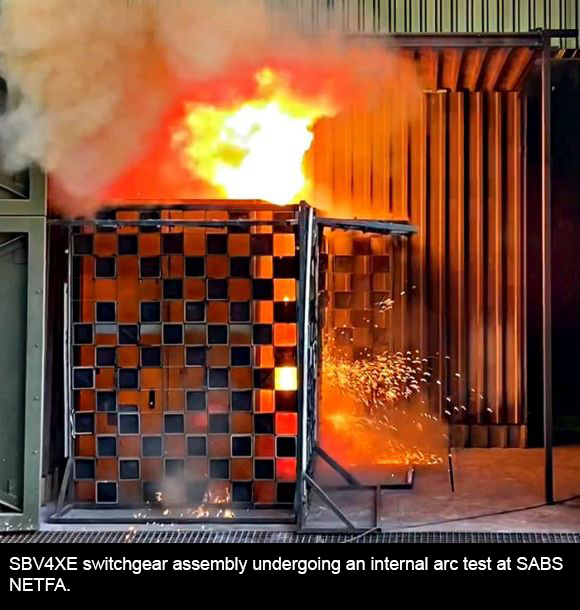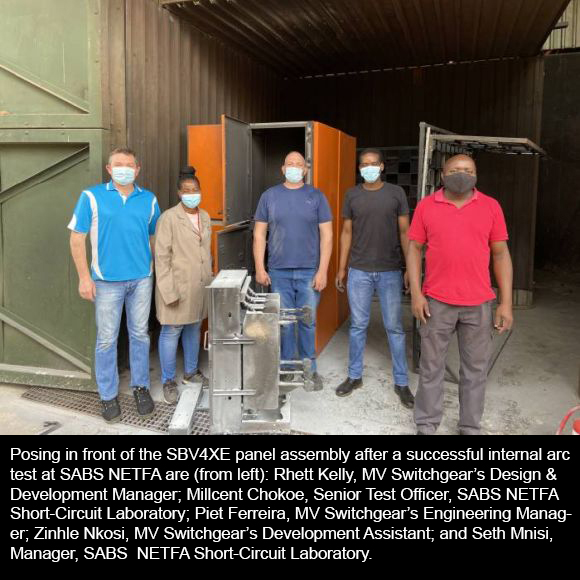Introduction
MV Switchgear commenced development of its SBV4XE switchgear, successor to its SBV4 and SBV4E products, in mid-2017.

SBV4XE represents a substantial advance over the existing SBV products. While it retains their well-proven ergonomic advantages, it incorporates a host of modern technological, functional and cost-saving features.
SBV4XE modelled on SBV4 and SBV4E
The main features of the withdrawable pattern SBV4 and later SBV4E switchgear ranges – on offer in Southern Africa since the early 1990’s – are their low profile and compactness, which makes them well-suited for applications with tight space constraints. These features, together with the switchgear’s robustness and adaptability, have contributed a great deal to their success and widespread use in the market.
In developing the new product, while retaining these important features, we set out to add a great deal more. In this we were guided by the experience gained in manufacturing switchgear over the past 50 years.
While the earlier generation SBV models continue to be produced for the extensive installed market and with AMV12 fulfilling the demands of major utilities requiring a mid-mount withdrawable circuit breaker having a 31.5kA for 1sec internal arc classification, the new SBV4XE, with its compact design and floor-rolling circuit breaker carriage, fits neatly between the two ends of this spectrum.
However, in closing the gap we’ve been able to re-imagine the SBV4E product with a number of significant enhancements added.
SBV4XE’s advanced features
The main features SBV4XE offers are:
- The spring-charging and cam-follower mechanisms are designed to incorporate less costly and more readily available alternative materials.
- The opening and closing releases require less energy to operate than in the earlier SBV models.
- With a lower parts count, the circuit-breaker operating mechanism requires less maintenance, so reducing the total cost of ownership.
- The vacuum interrupter pole assembly is more cost-competitive than the earlier models.
- Arc cooling pressure relief devices have been introduced into the housing assembly to reduce emissions released during an internal arc fault.
- The housing assembly is bolted and riveted, as opposed to being welded, making it more efficient to manufacture. It is primarily manufactured from aluminium and zinc coated steel sheeting in place of mild steel. The majority of parts therefore do not need to be painted and have inherent corrosion resistance and enhanced galvanic bonding properties compared with painted mild steel.
- As with the housing assembly, the carriage of the circuit breaker is also made of aluminium and zinc coated steel sheeting.
- The carriage latching, interlocking and racking mechanism has been redesigned to improve ease of operation, simplicity and functionality.
- The circuit breaker mechanism gears are a combination of polymeric and steel materials, resulting in an 80% reduction of steel compared to the traditional gears.
- The floor rolling circuit breaker carriage incorporates a chassis, the front of which is locked into position within the panel housing, allowing the circuit-breaker to be racked into and out of the service position on dedicated rails with greater ease while ensuring continuous alignment with the fixed contacts of the housing assembly.
- The circuit breaker carriage chassis has swivel wheels, allowing 3600 rotation and greatly facilitating its manoeuvrability outside the housing assembly.
- The ring bar and base current transformers (CTs) are manufactured using epoxy resin insulation with an earth screened bar primary and toroidal core (ring-type) CTs.
Type tests at KEMA and XIHARI
The first type tests to be carried out on SBV4XE by a world-recognised electrical test facility were conducted at the renowned KEMA electrical test centre in Arnhem, Holland, in mid-2018.
A 25kA new circuit breaker mechanism was successfully tested for short-time withstand current and the complete series of basic short-circuit switching duties in accordance with the international IEC 62271-200 and IEC 62271-100 standards. These tests qualified it for use on 11kV non-effectively earthed systems, such as those earthed via a high-impedance device.
The next set of tests were carried out in April 2019 at the reputable Xi’an High Voltage Apparatus Research Institute (XIHARI) in Xi’an, China. These tests, which completed the short-circuit performance type tests required for the SBV4XE model’s 630mm wide 25kA 800A and 1250A circuit breaker to conform to the latest edition of IEC 62271-100 standard, comprised:
- Electrical endurance testing for rapid auto-reclose applications, in which the circuit breaker achieved a Class E2 rating.
- Short-circuit test duties required to prove the circuit breaker’s performance for effectively earthed networks, as found typically in older distribution systems.
Final round of type tests at SABS
The final series of type tests were conducted on five separate occasions between January and October 2021 at the SA Bureau of Standards’ newly refurbished world-class National Electrical Test Facility’s (NETFA) High Power Test Laboratory in Olifantsfontein, just outside Johannesburg.
The type tests on the SBV4XE circuit breaker and housing assembly comprised temperature rise tests, dielectric tests and internal arc classification tests.
The temperature rise tests, conducted to prove the continuous current rating, were carried out with a housing assembly ingress protection (IP) code of IP4X, signifying that no foreign bodies of a diameter greater than or equal to 1mm can enter the housing assembly.
The dielectric tests were:
- Lightning impulse withstand voltage tests, successfully achieving the target of 95kV.
- Power frequency voltage withstand tests, successfully achieving the target of 28kV.
- Partial discharge tests, successfully achieving zero detectable partial discharge at 1.1 times the rated voltage, thereby exceeding the target of 20pC.
The internal arc tests, carried out to ensure a tested level of safety to authorised personnel and operators in the event of a fault occurring within the switchgear housing assembly, proved an internal arc classification (IAC) of AFLR 25kA 1sec.
The arc coolers proved highly effective, as they were shown to significantly reduce the amount of emitted burning particles and hot gases caused by a fault.
Conclusion
MV Switchgear is now able to offer a type-tested SBV4XE solution for ratings up to 1250A and 25kA. Designated areas within the division’s factory at Knights, Germiston, are being prepared for the manufacture of this range of switchgear, which will be introduced into the market early in 2022.
SBV4XE is a fully locally manufactured product. It combines the best features of its predecessors, the SBV4 and SBV4E models, together with other advantages, which include fewer parts, modern materials, more efficient manufacturing methods, enhanced operability and lower energy consumption.


